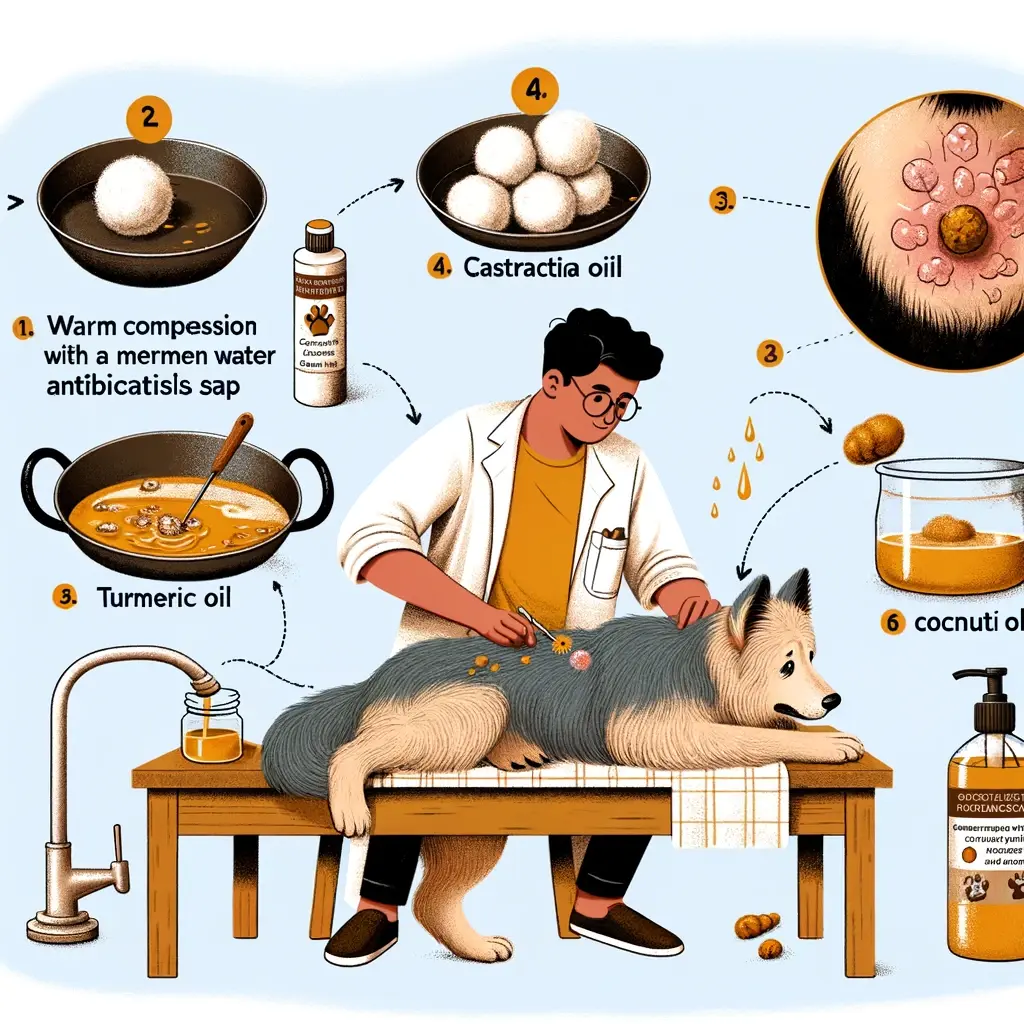Summary
Treating a ruptured dog cyst involves gently cleaning the area with warm water and applying a vet-prescribed topical antibiotic ointment to prevent infection. It’s crucial to prevent your dog from licking or scratching the cyst to allow proper healing. While some benign cysts can be managed at home with warm compresses, castor oil, turmeric paste, or coconut oil, always consult a veterinarian for diagnosis. Sudden or painful cysts, or those that appear infected, require professional evaluation to rule out cancerous growths or the need for surgical removal. Never delay veterinary care for concerning cysts.
What is a Cyst on Dogs?
Cysts are a type of pop-up structure that appears on the dogs’ skin; these are especially hollow spaces between the tissues of the dogs, which contain a kind of hard material or a fluid solution made up of sebum or sweat of the body.
The cyst can be classified into many types: true cysts, follicular cysts, sebaceous cysts, dermoid cysts, and false cysts.
Among all the cysts mentioned above, the cysts in dogs are the actual c. The true cysts are formed on the sweat glands and especially appear on the eyelids of the dog.
This cyst consists of a lining of cells named the epithelial lining, which separates the cysts from the tissues in the surrounding area.
What is the Cause Behind the Development of Cysts in Dogs?
As per the research done by cynologists on dogs, the information was obtained that the cause of cysts in an animal body is the effect of a local injury on the follicle.
Whereas with specific injuries, cysts in dogs can also be caused by the blockage of the follicles, famous as a skin condition called hidradenitis supportive, severe skin damage due to the sun’s ultraviolet radiation, and many others.
Dogs with very little fat and a thin coat have a greater chance of getting a cyst on the sternum or other pressure points.
Different dogs of different breeds can get spasms and irritation in other parts of their body as per the UV rays, resisting their capability and the strength of their immune system.
For example, dog breeds like Shih Tzus, Boxer dogs, Schnauzers, and Basset Hounds possess a genetic liability to the follicular cysts. Cysts or comedones can also develop in dogs, giving them easy exposure to drugs such as glucocorticoids.
How do cysts rupture, and is it harmful to dogs?
Cysts in dogs rupture when they get bigger, as the membrane holding the fluid substance loses the capability to have it anymore due to the increase in the amount of fluid in those hollow spaces within the tissues.
Although most of the cysts are not harmful to the canine, sebaceous cysts can cause severe discomfort to your pet, like it can cause itchiness, pain, and irritation in the affected area; thus, it is also distressing for the dog.
Unlike the other cysts, which are not bothersome to the canine, these sebaceous cysts need to be removed through a surgical process, as when the cyst causes pain and irritation to the organism, it can be infected and malignant.
Suppose a cyst that causes severe pain and irritation remains untreated. In that case, it can cause many other issues, such as filling up the cysts with bacteria and pus, thus leading to an abscess, which can cause blood poisoning if it bursts inside the body.
When is a Vet Visit Necessary, and How is it Diagnosed?
Suppose you notice that the cyst is causing severe pain and discomfort to the canine. In that case, you should never delay visiting a vet to treat the cyst, as it can even be life-threatening for the pet and must be surgically removed.
The first steps a veterinarian prefers when diagnosing a cyst in dogs are the biopsy and the microscopic examination of the tissues. A biopsy is a process where a pathologist carries out a microscopic piece of the cyst to research under the microscope to determine if it’s cancerous.
Histopathology is a process where the tissues are examined microscopically to allow the pathologist to evaluate if the entire cyst was ideally removed.
The process of histopathology is helpful for the diagnosis and works wonders in determining the cause behind the cyst and eliminating the other diseases.
Is Treating a Dog Cyst at Home Okay?
As discussed above, ruptured cysts in dogs can harm the canine’s health. Due to this, the dog owner is suggested to take the canine to a veterinarian to check if it is cancerous.
If the veterinarian declares the cyst is cancerous or malignant, the dog owner should rapidly go for the surgery and medications per the vet’s prescription.
But if the veterinarian declares that the cyst is normal, that means it is benign, and then it can be treated at home, as it was proved that home remedies work wonders in the secretion of that fluid substance from the cyst.
How to Treat a Ruptured Cyst on a Dog?
If your veterinarian has detected that the cysts of the canine are benign and there is no need for surgery, then you can cure it entirely at home by using some home remedies and the vet’s prescribed medicines. The steps that a dog owner can follow to treat the ruptured cyst of the dog at home are discussed below:
Warm Compression Over the Cyst
Applying warm compression over the cysts of the dog when they start to drain can work wonders for a proper cure for the ruptured cysts.
To give warm compression to the ruptured cysts, all the owner has to do is remove the hair around the lump with the help of a hair trimmer, then take a bowl, add a cup of warm water, and mix it with a tablespoon of antibacterial soap and dip a folded piece of cloth in the mixture and dap over the lump twice a day for a couple of days.
This process kills the bacteria inside the cyst, thus preventing the cyst from scabbing over.
Use of Castor Oil
There is no scientific evidence that castor oil can benefit the cysts in dogs, but dog owners used to say that they have got perfect results after its use.
To use castor oil, the dog owner has to take a bowl full of warm water and a few balls of cotton. First, the owner has to apply the wet cotton balls over the lump and then apply some castor oil over the lump.
Repeating this process three times a day for a week is sufficient for adequately treating the ruptured cyst at home.
Use of Turmeric
This Indian spice turmeric is well known for treating inflammations, rashes, and certain kinds of injuries over the skin.
Making a paste of turmeric with some droplets of water and then applying it over the lump can be very helpful in treating the bacteria inside the cyst, thus helping in treating the ruptured cyst in dogs.
Use of Coconut Oil
Like castor oil, coconut oil does not possess any scientific evidence for the treatment of cysts. However, as per the preferences of the dog owner, it is quite an effective method. Most dog owners have recorded that after one week of regular use, they have noticed that the dog’s lump appears smaller in size.
When using coconut oil, all the owner has to do is apply it on the fingers, rub it over the cyst with light hands, and repeat it twice a day for a week.
All the above-discussed steps are based on the preferences of dog owners who have treated the ruptured cysts of their canine at home. So, if a dog owner is looking for steps for a particular treatment, they can entirely rely upon the above steps to get the best results.
All of the tips mentioned above on how to treat a ruptured cyst on a dog are mere home remedies. Sometimes, cysts can infect the dog’s body parts, so you need to visit the vet to confirm the seriousness of the issue.


